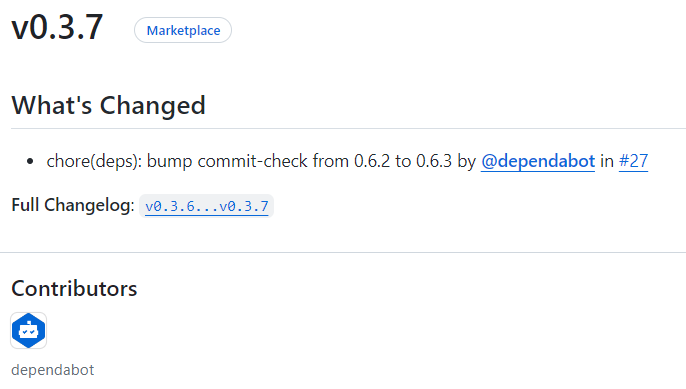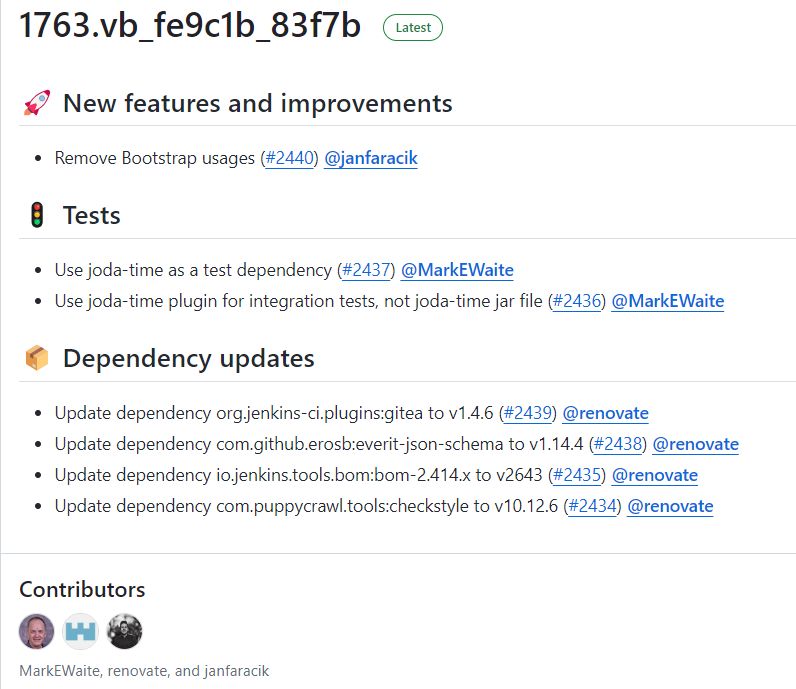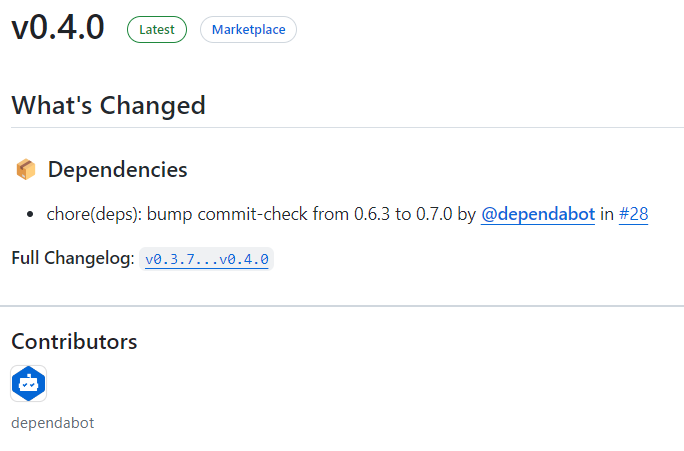如果你使用过 GitHub 发布过项目,你会知道 GitHub 可以自动生成 Release Notes。
就像这样 GitHub 自动生成的 Release Notes。

这个截图里的 Release Notes 内容很少,看起来还很清晰。但如果内容很多,以 Jenkinsci 组织下的 configuration-as-code-plugin 项目为例,可以看出来这里的 Release Notes 中的内容是按照标题进行分类的,假如这些内容混在一起将会非常糟糕的体验。(不要误以为这是手动进行分类的,程序员才不愿意干这种事😅)

本文将分享针对需要对 GitHub Release Notes 的内容按照标题进行自动分类的两种方式。
方式一:使用 GitHub 官方提供的功能#
方式一是通过 GitHub 提供的功能对 Release Notes 进行自动分类,即在仓库下面创建配置文件 .github/release.yml。这个功能与 GitHub 的 Issue Template 和 Pull Request Template 类似。具体的配置选项可以参考官方文档
以下我是在 commit-check-action 项目的配置
changelog:
exclude:
labels:
- ignore-for-release
categories:
- title: '🔥 Breaking Changes'
labels:
- 'breaking'
- title: 🏕 Features
labels:
- 'enhancement'
- title: '🐛 Bug Fixes'
labels:
- 'bug'
- title: '👋 Deprecated'
labels:
- 'deprecation'
- title: 📦 Dependencies
labels:
- dependencies
- title: Other Changes
labels:
- "*"
针对上面的示例,在添加了 .github/release.yml 配置文件之后,当再次生成 Release Notes 时就会自动将其内容进行自动归类(下图中的标题 📦 Dependencies 是自动添加的)

方式二:使用 Release Drafter#
方式二是使用 Release Drafter,即在仓库创建配置文件 .github/release-drafter.yml。
从 Release Drafter 项目提供的配置参数可以看出来它提供的功能更多,使用也更加复杂。另外它还支持将配置文件放到组织下的中央仓库 .github 来实现统一的配置、并将其共享给其他仓库。
目前方式一
.github/release.yml不支持通过中央仓库.github来实现统一的配置,详见这个讨论。
这里还以 jenkinsci/configuration-as-code-plugin 为例看到它的 .github/release-drafter.yml 的配置。
_extends: .github
这个配置的 _extends: .github 表示从中央仓库 .github/.github/release-drafter.yml 继承过来的配置。
# Configuration for Release Drafter: https://github.com/toolmantim/release-drafter
name-template: $NEXT_MINOR_VERSION
tag-template: $NEXT_MINOR_VERSION
# Uses a more common 2-digit versioning in Jenkins plugins. Can be replaced by semver: $MAJOR.$MINOR.$PATCH
version-template: $MAJOR.$MINOR
# Emoji reference: https://gitmoji.carloscuesta.me/
# If adding categories, please also update: https://github.com/jenkins-infra/jenkins-maven-cd-action/blob/master/action.yaml#L16
categories:
- title: 💥 Breaking changes
labels:
- breaking
- title: 🚨 Removed
labels:
- removed
- title: 🎉 Major features and improvements
labels:
- major-enhancement
- major-rfe
- title: 🐛 Major bug fixes
labels:
- major-bug
- title: ⚠️ Deprecated
labels:
- deprecated
- title: 🚀 New features and improvements
labels:
- enhancement
- feature
- rfe
- title: 🐛 Bug fixes
labels:
- bug
- fix
- bugfix
- regression
- regression-fix
- title: 🌐 Localization and translation
labels:
- localization
- title: 👷 Changes for plugin developers
labels:
- developer
- title: 📝 Documentation updates
labels:
- documentation
- title: 👻 Maintenance
labels:
- chore
- internal
- maintenance
- title: 🚦 Tests
labels:
- test
- tests
- title: ✍ Other changes
# Default label used by Dependabot
- title: 📦 Dependency updates
labels:
- dependencies
collapse-after: 15
exclude-labels:
- reverted
- no-changelog
- skip-changelog
- invalid
template: |
<!-- Optional: add a release summary here -->
$CHANGES
replacers:
- search: '/\[*JENKINS-(\d+)\]*\s*-*\s*/g'
replace: '[JENKINS-$1](https://issues.jenkins.io/browse/JENKINS-$1) - '
- search: '/\[*HELPDESK-(\d+)\]*\s*-*\s*/g'
replace: '[HELPDESK-$1](https://github.com/jenkins-infra/helpdesk/issues/$1) - '
# TODO(oleg_nenashev): Find a better way to reference issues
- search: '/\[*SECURITY-(\d+)\]*\s*-*\s*/g'
replace: '[SECURITY-$1](https://jenkins.io/security/advisories/) - '
- search: '/\[*JEP-(\d+)\]*\s*-*\s*/g'
replace: '[JEP-$1](https://github.com/jenkinsci/jep/tree/master/jep/$1) - '
- search: '/CVE-(\d{4})-(\d+)/g'
replace: 'https://cve.mitre.org/cgi-bin/cvename.cgi?name=CVE-$1-$2'
- search: 'JFR'
replace: 'Jenkinsfile Runner'
- search: 'CWP'
replace: 'Custom WAR Packager'
- search: '@dependabot-preview'
replace: '@dependabot'
autolabeler:
- label: 'documentation'
files:
- '*.md'
branch:
- '/docs{0,1}\/.+/'
- label: 'bug'
branch:
- '/fix\/.+/'
title:
- '/fix/i'
- label: 'enhancement'
branch:
- '/feature\/.+/'
body:
- '/JENKINS-[0-9]{1,4}/'
以上是中央仓库的 .github/.github/release-drafter.yml 配置,可以看到 Jenkins 官方使用了很多特性,比如模板、替换、自动加 label 等,需要在通读 Release Drafter 的文档之后能更好的理解和使用。
总结#
以上两种方式都可以帮助你在自动生成 Release Notes 的时候自动进行标题分类,但两者有一些如下差别,了解它们可以帮助你更好的进行选择。
- GitHub 官方提供的方式更容易理解和配置,可以满足绝大多数的项目需求。主要的不足是不支持从中央仓库
.github中读取.github/release.yml。 - Release Drafter 提供了更为强大的功能,比如模板、排序、替换、自动对 pull request 加 label 等等,尤其是可以通过中央仓库来设置一个模板,其他项目来继承其配置。
如果是大型的开源组织,Release Drafter 是更好的选择,因为它提供了强大的功能以及支持继承中央仓库配置。如果是个人项目,GitHub 官方提供的方式基本满足需求。
以上就是我对两个生成 GitHub Release Notes 并进行自动分类的分享。
如果有任何疑问或建议欢迎在评论区留言。
转载本站文章请注明作者和出处,请勿用于任何商业用途。欢迎关注公众号「DevOps攻城狮」

